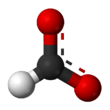Sodium formate
| Sodium formate | |
|---|---|
 | |
 |
 |
| Other names formic acid, sodium salt | |
| Identifiers | |
| CAS number | 141-53-7 |
| PubChem | 2723810 |
| ChemSpider | 8517 |
| UNII | 387AD98770 |
| EC number | 205-488-0 |
| ChEMBL | CHEMBL183491 |
| Jmol-3D images | {{#if:[Na+].[O-]C=O|Image 1 |
| |
| |
| Properties | |
| Molecular formula | HCOONa |
| Molar mass | 68.007 g/mol |
| Appearance | white granules deliquescent |
| Density | 1.92 g/cm3 (20 °C) |
| Melting point | 253 °C; 487 °F; 526 K |
| Boiling point | decomposes |
| Solubility in water | 97.2 g/100 mL (20 °C) 160 g/100 mL (100 °C) |
| Solubility | insoluble in ether soluble in glycerol, alcohol |
| Acidity (pKa) | 7.0-8.5 (0.1M) |
| Hazards | |
| EU classification | not listed |
| NFPA 704 |
 0
1
0
|
| Except where noted otherwise, data are given for materials in their standard state (at 25 °C (77 °F), 100 kPa) | |
| Infobox references | |
Sodium formate, HCOONa, is the sodium salt of formic acid, HCOOH. It usually appears as a white deliquescent powder.
Uses
Sodium formate is used in several fabric dyeing and printing processes. It is also used as a buffering agent for strong mineral acids to increase their pH, as a food additive (E237), and as a de-iceing agent.
Preparation
Sodium formate can be prepared in the laboratory by neutralizing formic acid with sodium carbonate. It can also be obtained by reacting chloroform with an alcoholic solution of sodium hydroxide.
or by reacting sodium hydroxide with chloral hydrate.
- C2HCl3(OH)2 + NaOH → CHCl3 + HCOONa + H2O
The latter method is, in general, preferred to the former because the low aqueous solubility of CHCl3 makes it easier to separate out from the sodium formate solution, by fractional crystallization, than the soluble NaCl would be.
For commercial use, sodium formate is produced by absorbing carbon monoxide under pressure in solid sodium hydroxide at 160 °C.
Sodium formate may also be created via the haloform reaction between ethanol and sodium hypochlorite in the presence of a base. This procedure is well documented for the preparation of chloroform.